|
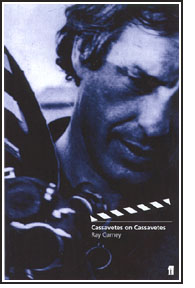 "What
a great gift you've given to young filmmakers everywhere. Your book,
Cassavetes on Cassavetes, made me miss him even more. I
didn't think it possible."—Ben Gazzara, the star of Cassavetes' Husbands
and The Killing of
a Chinese Bookie "What
a great gift you've given to young filmmakers everywhere. Your book,
Cassavetes on Cassavetes, made me miss him even more. I
didn't think it possible."—Ben Gazzara, the star of Cassavetes' Husbands
and The Killing of
a Chinese Bookie
"Thank
God for Ray Carney's Cassavetes
on Cassavetes. It captures the man I knew—the most
vivid, colorful, intriguing, infuriating, fertile, man, child,
artist, actor, friend. It's all there. The passion, the craziness,
the complexity,
the mystery. There'll never be another like him. It's a terrific
book."—Peter Falk, star of Husbands
and A Woman Under
the Influence
"Fascinating
footage of the mind and heart of an American original."—Kirkus
Reviews
"Reading
this book is like attending an extended master class at the
Actors
Studio, a reminder of a rebellious spirit sadly missed."—Stephen
Rees, Library
Journal
For more than thirty
years – from the late 1950s through the late 1980s – John
Cassavetes, the spiritual father of American independent filmmaking,
steered a courageous course freelancing on the fringes of the Hollywood
studio system. During his lifetime, with the exception of A
Woman Under the Influence and Faces, his work was
largely ignored by reviewers (when it wasn't simply ridiculed),
but in the years
since his death he has been re-discovered by a new generation of
viewers and artists. He has become a cult figure with millions
of
young followers. He and his films are bigger today than at any
point in his lifetime.
Cassavetes on Cassavetes
is the autobiography he never lived to write. In his own words
Cassavetes tells the story of his life as he lived it, day
by day, year by
year. He begins with his family and childhood experiences, talks
about being a high school student, college dropout, and drama
school
student. He describes the years he spent pounding the pavement
in New York as a young unemployed actor unable to get a job – or
even an agent. Then he takes the reader behind the scenes
to sit
in on the planning, rehearsing, shooting, and editing of each of
his 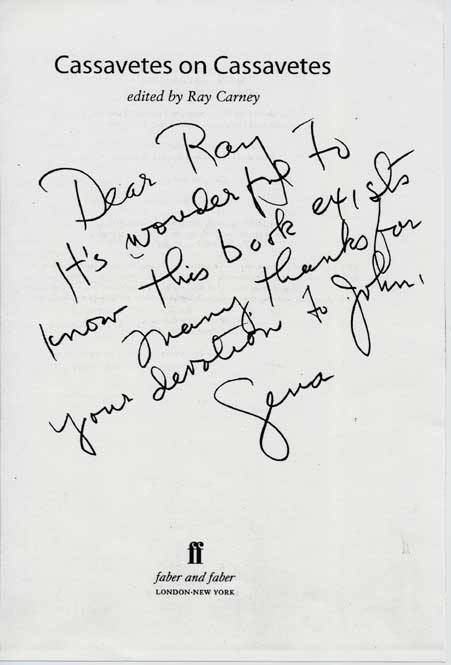 films – from Shadows, Faces,
and Husbands,
to Minnie and Moskowitz, A Woman Under the Influence,
The Killing of a Chinese Bookie, Opening Night, Gloria,
and Love Streams. He describes the battle to get them made,
and the even greater struggle to get them into movie theaters.
He
talks about the reaction of audiences and reviewers to his work,
and responds to criticisms of it. This is Cassavetes at his most
candid and outspoken – uncompromising, humane, and passionate
about life and art. films – from Shadows, Faces,
and Husbands,
to Minnie and Moskowitz, A Woman Under the Influence,
The Killing of a Chinese Bookie, Opening Night, Gloria,
and Love Streams. He describes the battle to get them made,
and the even greater struggle to get them into movie theaters.
He
talks about the reaction of audiences and reviewers to his work,
and responds to criticisms of it. This is Cassavetes at his most
candid and outspoken – uncompromising, humane, and passionate
about life and art.
The tale is a personal
one: of dreams, struggles, triumphs, setbacks, and frustrations;
of high-stakes financial gambles, crazy artistic risk-taking, and
midnight visions of glory. But it is also the story of an artistic
movement that extended beyond Cassavetes and defined an era in
film history. Between the lines as it were, these pages chronicle
the
history of one of the most important artistic movements of the
past fifty years – the birth and development of American
independent filmmaking – and the response to it by critics
and reviewers.
Cassavetes pioneered
a new conception of what film can be and do – a vision
of it as a personal exploration of the meaning of his life
and the lives
of the people around him. He made his movies the way poets write
or painters paint. It was not about telling a hyped-up dramatic
story to take people away from their lives, but a way of asking
deep, probing questions about the world in which he lived,
and of
asking viewers to explore the meaning of their experiences. Cassavetes
on Cassavetes traces the cultural trajectory of that idea,
and the wildly opposed responses it elicited: the incredible
energy
and excitement it engendered among certain artists, critics, and
viewers; and the fierce resistance it met with from uncomprehending
studio heads, producers, distributors, reviewers, and audiences
fighting to hold onto their notion of the movies as "story-telling"
or "entertainment." It’s not too much to say that
Cassavetes was engaged in a struggle for the soul of American
film,
and that the battle is not over; it continues today.
The
opinion of Harmony Korine, writer-director of Kids, Gummo, Julian
Donkey-Boy about Ray Carney's Cassavetes on
Cassavetes:
"THE
BEST FILM BOOK EVER WRITTEN."
|
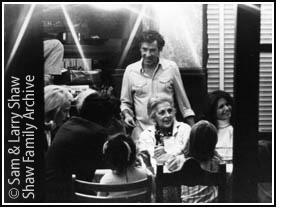 Ray Carney, the world’s
leading authority on Cassavetes’ life and work, plumbs the
depths of Cassavetes' soul, presenting both a spiritual portrait
of the artist and a soul-searching meditation on Cassavetes' more
than half-doomed attempt to create works of art in a commercial
medium like film. Carney says his goal was to "get beyond the
press release version" of Cassavetes’ life. "I wanted
to tell the real story of the predicament of the American film artist....
to show what it really is like to be an artist in a commercial
medium like film and a business-oriented culture like the one we
live in. You read the film magazines and watch the TV talk-shows,
and they make being an ‘indie’ sound exotic and glamorous
and exciting, but the truth is that anyone who attempts to make
films that are more than entertainment in America is almost certainly
doomed to be neglected or reviled by newspaper and magazine reviewers,
who are almost all under the sway of Hollywood entertainment values.
Every generation fools itself and thinks that it is wiser than its
predecessors, but the next Cassavetes, the young artist trying to
do interesting things today, is in exactly the same situation Cassavetes
was. Cassavetes still has a lot to teach us." Ray Carney, the world’s
leading authority on Cassavetes’ life and work, plumbs the
depths of Cassavetes' soul, presenting both a spiritual portrait
of the artist and a soul-searching meditation on Cassavetes' more
than half-doomed attempt to create works of art in a commercial
medium like film. Carney says his goal was to "get beyond the
press release version" of Cassavetes’ life. "I wanted
to tell the real story of the predicament of the American film artist....
to show what it really is like to be an artist in a commercial
medium like film and a business-oriented culture like the one we
live in. You read the film magazines and watch the TV talk-shows,
and they make being an ‘indie’ sound exotic and glamorous
and exciting, but the truth is that anyone who attempts to make
films that are more than entertainment in America is almost certainly
doomed to be neglected or reviled by newspaper and magazine reviewers,
who are almost all under the sway of Hollywood entertainment values.
Every generation fools itself and thinks that it is wiser than its
predecessors, but the next Cassavetes, the young artist trying to
do interesting things today, is in exactly the same situation Cassavetes
was. Cassavetes still has a lot to teach us."
These
pages capture the spirits that possessed Cassavetes’ soul – the
filmmaker’s cultivated alienation, loneliness, self-destructiveness,
ambition, unpredictable fits of anger, desperation, self-protective
clowning, need to be the center of attention, and inability to
work as a member of a group or for anyone else. They subtly
hint at spooky
similarities between the artist and his demon-driven protagonists
(all of whom are in states of emotional extremity, most of
whom
attempt suicide or throw themselves into orgies of self-destruction
at some point in their films).
The
opinion of Xan Cassavetes, John Cassavetes' daughter
and the director of Z Channel and other works,
about Ray Carney's Cassavetes on Cassavetes,
as relayed to Carney by a friend in Los Angeles (stars
indicate omitted personal material):
"I
am still in LA, working on *** , which is coming along.
Real progress. This evening saw Z CHANNEL, a new
documentary by Xan Cassavetes. *** I spoke with her after
the screening. I thought you might like to know that
she absolutely loves CASS ON CASS. Says she sleeps
with it. Says it's enabled her to have conversations
with her father she never had."
|
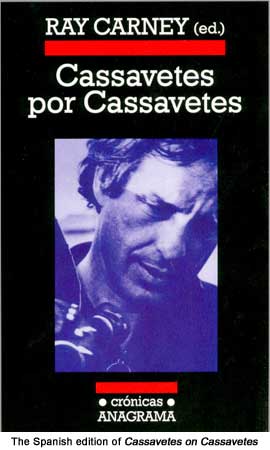 Carney
spent eleven years assembling the text, editing it down from more
than five thousand pages of original source material. It was based
on extensive interviews with the filmmaker during the final decade
of his life, and on both new and previously published interviews
with virtually everyone who ever worked with Cassavetes –
from stars like Gena Rowlands, Peter Falk, and Ben Gazzara to artistic
collaborators and friends like Ted Allan, Sam Shaw, Al Ruban, and
Elaine May. Carney
spent eleven years assembling the text, editing it down from more
than five thousand pages of original source material. It was based
on extensive interviews with the filmmaker during the final decade
of his life, and on both new and previously published interviews
with virtually everyone who ever worked with Cassavetes –
from stars like Gena Rowlands, Peter Falk, and Ben Gazzara to artistic
collaborators and friends like Ted Allan, Sam Shaw, Al Ruban, and
Elaine May.
With Cassavetes on
Cassavetes, Carney has created a contemporary version of Stanislavski’s
My Life in Art for film and for our time. It is a book that
will enlighten and inspire drama students, actors, filmmakers, and
artists everywhere.
Illustrated with more
than sixty pages of previously unpublished behind-the-scenes photographs.
544 pages.
***
Since this
is the first time Cassavetes’ life story has been told (and
since he lied to journalists about many of the events in his life),
many of the facts Carney reveals have not been known outside the
inner circle of Cassavetes’ friends and family. Many facets
of the story will be unfamiliar even to someone who has read all
of the standard journalistic treatments and film encyclopedia entries.
A few highlights (all references are to book pages):
The kinks
and twists in Cassavetes’ psyche and his embattled cultivation
of his "outsider" status are captured here for the first
time:
• His
brushes with the law, playing "chicken" on the Port Washington
sand-pit cliffs in his teen years, and feelings of oppression at
the narrowness and conformity of American culture when he was in
high school (pp. 10-11).
• His
"crazy" behavior as an aspiring actor fighting for work
in New York and the "lone wolf" side of his personality
his flamboyance camouflaged (pp. 20-24).
• His
occasional ruthlessness and "use" of people to further
his own agenda, with details about more than one lawsuit initiated
or threatened by his co-workers (pp. 73-5, 99-100, and 179-80).
• His
legendary fights with Pauline Kael, his wife, Gena Rowlands, and
other actors and journalists (pp. 171-2, 246-52, 283-4, and 330-33).
There
are many uncensored, behind-the-scenes accounts of the creation
of the films. Some excerpts: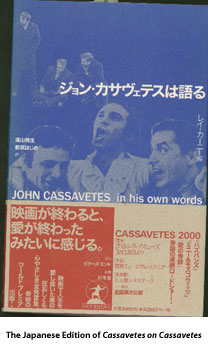
• The
half-drunken "six-month traveling house party" that resulted
in Faces (pp. 144-8).
•
The first in-depth explanation of what Cassavetes actually meant
when he used the word "improvisation" to describe his
actors’ performances (pp. 161-6 and 323-7).
• The
outrageous pitch Cassavetes made to a gullible Italian millionaire
that resulted in Husbands, committing Peter Falk and Ben
Gazzara to act in it, when Cassavetes had not yet written the first
word of the script or told the two actors that he was using their
names (pp. 204-8).
The deeply
autobiographical basis of Cassavetes’ work–its grounding
in his own life and relationships:
• Cassavetes’
feelings of being an outsider to New York society and of "passing"
for something he was not at the point at which he made Shadows.
The deep similarity between the character of Ben in Shadows
and himself (pp. 58 and 257-8).
• The
veiled self-portrait of his own commercial "sell-out"
after making Shadows that is woven into Too Late Blues
(pp. 107-8).
•
Cassavetes’ depiction of his own life and marriage in the central
couple of Faces, with the Maria Forst character originally
being written for Gena Rowlands to play (pp. 134-5 and 138-9).
•
The portrait of Cassavetes’ own courtship of Rowlands and the
differences in their personalities dramatized in Minnie and Moskowitz
(p. 277).
• The
autobiographical resonances of the marriage in A Woman Under
the Influence, but with a gender reversal that fooled the critics
who identified Rowlands with Mabel. In real life, Rowlands played
Nick to Cassavetes’ Mabel (pp. 362-3).
• The self-portrait of the artist as a struggling repertory
theater company manager in The Killing of a Chinese Bookie
(pp. 382-5). • In
Gloria, the comical similarity between the midget macho-man
Phil and his creator (p. 448).
• The
connections between Cassavetes and Robert Harmon in Love Streams,
Cassavetes’ farewell to filmmaking, made when he knew he only
had a short time to live (475-81 and 500).
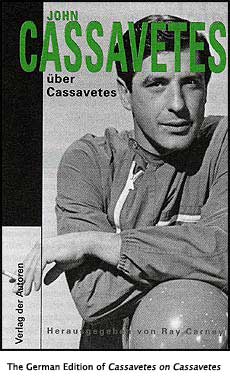 The hair-raising
financial gambles and bureaucratic struggles that went into making
and distributing the films: The hair-raising
financial gambles and bureaucratic struggles that went into making
and distributing the films:
• The
near derailing of Husbands when financing was withdrawn only
days before shooting was scheduled to start (pp. 224-7).
• The
fights with Columbia over the length of Husbands and the
"vomiting scene" (pp. 252-7) and with Lew Wasserman over
the publicity and distribution of Minnie and Moskowitz (pp.
293-5).
• The
probable use of porno-film "short ends" to make A Woman
Under the Influence (p. 319); Cassavetes’ "blackmailing"
the New York Film Festival to get the film screened (pp. 355-7);
his reluctant foray into self-distribution (pp. 358-61); and his
"Fuck ‘em" response to the film’s Academy Awards
nominations (p. 364).
• The
crushing defeats Cassavetes encountered when he attempted to self-distribute
The Killing of a Chinese Bookie (pp. 397-400) and Opening
Night (pp. 426-31).
• Cassavetes’
abortive attempts to get a series of cinematic projects off the
ground in his final years, his turn to play-writing and dramatic
production, and the gradual decline of his health as a result of
what he euphemistically called the effects of "too much artistic
living" (pp. 501-12).
ABOUT THE EDITOR
Ray Carney is Professor of Film and American Studies and Director
of the undergraduate and graduate Film Studies programs at Boston
University.
He is the author or editor of more than ten books, including the
critically acclaimed The Films of Mike Leigh: Embracing
the World; The Films of John Cassavetes: Pragmatism, Modernism,
and the Movies;
American Vision: The Films of Frank Capra; Speaking the Language
of Desire: The Films of Carl Dreyer; American Dreaming;
and the newly published monograph on Cassavetes’ Shadows
for the BFI Film Classics series and the guide to his films:
John Cassavetes: The Adventure of Insecurity. He co-curated
The Beat Culture and the New America show for the Whitney Museum
of American Art in New York, is General Editor of the Cambridge
Film Classics series, and is a frequent speaker at film festivals
and special events around the world.
He is an acknowledged scholarly expert on independent film and American
art and culture.
CASSAVETES on CASSAVETES
is published by Faber and Faber (England)
Farrar,
Straus and Giroux (US)
$25.00
ISBN 0-57120-157-1
This
page contains a description of Ray Carney's Cassavetes on Cassavetes.
To learn how to obtain the book, please click
here.
|









